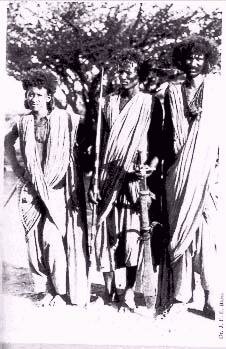
Shilluk male

Early Western scholars often confounded their own arguments by assuming that "Hamitic" theory was valid. Toynbee was one of the more notable authors to make such a mistake. Although he believed "Negroes" were not present in ancient Egypt, he nevertheless followed Gordon Childe�s views regarding the Shilluk, a Nilotic people from Sudan.

Shilluk male
Toynbee claimed that the Shilluk were the closest approximation physically and culturally to the predynastic Egyptians. The author seemed influenced by the preconception that the Hamitic Shilluk must have had a "Middle Eastern" appearance. Henri Frankfort and C. G. Seligman also noted the close relationship of the Shilluk with early dynastic Egypt. In particular, they notice a very close similarity in ritual objects. Seligman, apparently unable to reconcile the relationship between ancient Egyptian and Shilluk symbolism, regalia and customs sought to use the Hamitic theory as an explanation. He tried to show a physical gradient with "elongated" Africans representing Hamites and "broad" Africans portrayed as foreign elements.

"Aristocrat" Shilluk as opposed to the "ordinary" ones shown above.

Sir E.A. Wallis Budge stated that the Beja languages of the Eastern Sudan were the best to study in order to understand ancient Egyptian. Seligman thought the Beja were a throwback to dynastic times. Indeed, cave paintings in Egypt going back to 2000 BCE show Africoid hairstyles similar to those worn by the Beja. In modern times, they gained fame for their near fanatical resistance against the British under the Mahdi of Sudan.

Beja youth
Rudyard Kipling called them "Fuzzy Wuzzies" because of their great crowns of hair. As with the Shilluk, the Beja may be preconceived as Caucasoids because of the Hamitic tag, yet many are jet black in complexion. They have occupied the region from southern Egypt to Ethiopia, including cities along the Nile such as Karnak, Luxor and Aswan, since about 4000 BCE.


A common argument used against the Afrocentric theory is that ancient Egyptians were originally from the Sahara. This is only partly true, as it is easy to show that ancient Nubian types were closest to the early Egyptians. However, to often it is assumed that the Saharans who came in the region of Nubia and southern Egypt were white. Many theorized that the closest people to the ancient Saharans who migrated into Egypt are the modern Haratin. Whether these same scholars realized the physical type of the Haratin is not known. One study even showed that the Haratin had the closest blood type affinity to the samples left by the pharaohs of Egypt. However, a cursory study of ethnographic literature on the Haratin will reveal that they are most commonly described as "Negroid."
Credits
Photographs of Shilluk from C.B. Seligman and Brenda Seligman, Pagan Tribes of Nilotic Sudan, (London: George Rutledge & Sons, Ltd., 1932).
Photographs of Beja from Richard Carlisle, The Illustrated Encyclopedia of Mankind, (New York: M. Cavendish, 1989).
Image of Haratin from http://geogweb.berkeley.edu/GeoImages/Miller/maroc/family2.jpg.

Report any problems to Paul Kekai Manansala at
Sponsored by AsiaPacificUniverse.com
Just click the link above and sign up!